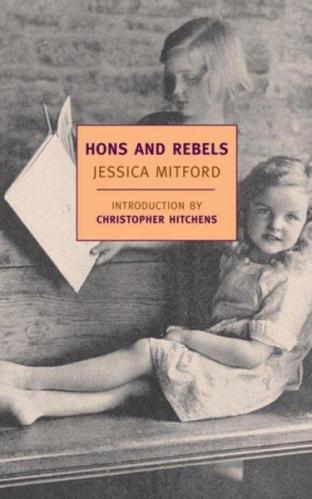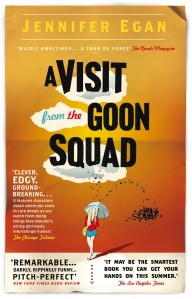Hons and Rebels by Jessica Mitf ord is probably my very favourite memoir (though the devotee of fiction I am, I must admit haven’t read very many). My fondness for it most likely arises from the fact that the book overall very much reads like fiction. It is, in effect, a bildungsroman with so many fantastical elements, flights of destiny and eccentric characters, that it hardly seems true that such people lived- yet the sheer forcefulness of their personalities, most of all its authoress, the indomitable Jessica Mitford- commands belief in their existence as living and breathing figures of history.
ord is probably my very favourite memoir (though the devotee of fiction I am, I must admit haven’t read very many). My fondness for it most likely arises from the fact that the book overall very much reads like fiction. It is, in effect, a bildungsroman with so many fantastical elements, flights of destiny and eccentric characters, that it hardly seems true that such people lived- yet the sheer forcefulness of their personalities, most of all its authoress, the indomitable Jessica Mitford- commands belief in their existence as living and breathing figures of history.
Further reading such as Mary Lovell’s excellent biography: The Mitford Sisters and Charlotte Mosley’s The Mitfords: Letters Between Six Sisters reveal that several elements of Hons and Rebels were embellishments and some, outright fiction, yet this revelation, for myself anyway, does not diminish the delights of this memoir- nor the extraordinary life of its author.
Hons and Rebels’ closest fictional precedents are of course, Nancy Mitford’s two most famous novels: The Pursuit of Love and Love in a Cold Climate. These two novels deserve a post entirely devoted to them, so I won’t go into detail here, only to say that the similarity lies foremost on the shared, exquisite rendering of the same famous family: Baron Redesdale and his six notorious daughters.
I have included short biography of each sister below (as they are too fascinating not to mention):
- Nancy, famed novelist and notorious snob (having also written Noblesse Oblige, a seminal essay on the linguistic differences between U (Upper) and Non-U).
- Diana, ‘the nearest thing to Botticelli’s Venus’, whose famed beauty obscured a more sinister personality. She was briefly married to Bryan Walter Guinness, of Guinness Beers fame before famously bolted into the arms of Oswald Mosley, leader of the British Union of Fascists. Their wedding was held in the home of Joseph Goebbels. The chief guest of honour? Adolf Hitler.
- Pamela, the ‘Rural Mitford’, who for years was the model of domesticity with her husband, the famous physicist, Derek Jackson. Yet she would later divorce her husband a live out her days as the companion of Giuditta Tommasi, an Italian horsewoman.
- Unity, the most maddening, enigmatic and elusive of all the Mitford girls, whose desire to be different found the most fatalistic source in Adolf Hitler. Unity’s obsession of the Furhrer would lead her to the innermost circles of the Third Reich-as Hitler’s unofficial mistress-and later to tragedy. An attempted suicide on the day that Britain declared war on Germany would lead her to be brain damaged for the rest of her short life.
- Deborah, whose ambition to become a duchess was perfectly fulfilled when she married Andrew Cavendish and become chatelaine of Chatsworth (the inspiration for Pemberley).
And of course my very favourite Mitford, Jessica (Decca): The eponymous rebel who among many other things would reject her family’s wealth and fascination with fascism by eloping with her cousin (and Sir Winston Churchill’s nephew) Esmond Romily to fight against the fascists in the Spanish Civil War, run away to America, open a bar in Miami, become a communist from 1943 and an active figure in the American Civil rights movement, become a famous muckraker- redefining investigative journalism through her seminal essay on the American funeral industry: The American way of Death-at the same time keeping correspondence with some of the most notable figures of the 20th century as Martin Luther King, Maya Angelou,Winston Churchill, Evelyn Waugh and Hilary Clinton among others. At age 76 she also tried her hand at music, releasing an album: Decca and the Dectones.
Only a tiny sliver of of Decca Mitford’s extraordinary life is recorded in Hons and Rebels (she would later write a sequel on her communist days in A Fine Old Conflict). What is recalled in this all too brief memoir though is deeply diverting, funny but also very moving.
Reading this as an adult rather than a child (I really rather regret the fact that my eleven year old self was deprived of this book), what strikes me most is Jessica’s deep fury and resentment at her parents for a sheltered childhood and lack of education, the type of anger that quietly pervades both Virginia Woolf’s A Room of One’s Own and a more recent counterpoint Lyn Barber’s An Education. It was in fact Jessica Mitford’s great regret that she never attended university. As someone who often begrudges the fact that she has spent so much time at university, this fact is both deeply moving and heartening.
Nevertheless, Hons and Rebels is generally very funny and deeply entertaining, peppered with figures who appear closer to Wodehouse and Waugh than E.M. Forster. Baron Revesdale (Farve) the most memorable of the lot is as indomitable, peerless and ridiculous as his fictional counterpart, Uncle Matthew. Hons and Rebels is abound with all the hallmarks of great children’s literature: naughty children, secret languages (Boudledidge), running away accounts and a menagerie of animals and above all, a highly memorable rendering of a momentous period of English social history.
Here in Hons and Rebels, Jessica succinctly encapsulates the insouciance and the excesses of the Jazz age, England’s dangerous flirtation with fascism, the growing malcontent of Western Europe and the outbreak of radical thought, as well as the impending World War. The combative political tension of the period is succinctly expressed and yet satirically figured in Decca’s description of her shared room with her (ironically) favourite sister Unity:
“We divided it down the middle, and Boud (Unity) decorated her side with Fascist insignia of all kinds- the Italian ‘fasces’, a budge of sticks bound in rope, photographs of Mussolini framed in passe-partout; photographs of Mosely trying to look like Mussolini; the new German swastika; a record collection of Nazi and Italian youth songs. My side was fixed up with my communist library, a small bust of Lenin purchased for a shilling in a second-hand shop, a file of Daily Workers. Sometimes we would barricade with chairs and stage pitched battles, throwing books and records until Nanny came to tell us to stop the noise.”
Hons and Rebels pg. 71
Hons and Rebels has also been greatly loved by good deal of notable people. Perhaps solely due to his excellent writing on Jessica Mitford -including a preface to Hons and Rebels– I have begun to loathe Christopher Hitchens just a little bit less. More welcome however was the discovery that Hons and Rebels was also J.K. Rowling’s favourite book as a child and that Jessica Mitford was a personal hero and as well the namesake for Rowling’s first child.
Like Rowling, I’ve begun to regard as Mitford as a great personal heroine, not so much for her politics (for it is clear that she could be as wilfully stubborn and close-minded as her sisters) but her great capacity for wit, her irrepressible naughtiness, her muckraking ways and her deep interest in the sufferings of those less fortunate from her. Most of all I admire her vivid voice, the keenness of her eye and her indefatigable ability to face the vicissitudes and disappointments of life- not retiring to the drawing room, but kicking and screaming.


